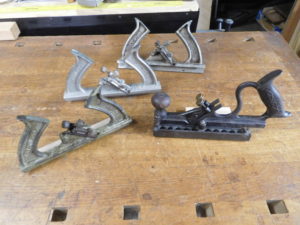Is the tongue and groove joint dying? Early examples of surviving furniture show that ancient woodworkers have used tongue and groove joints for thousands of years. Yet modern woodworkers seem to be reluctant to incorporate T&G joinery in their projects. Why is this? Have modern glues and plywood paneling reduced the need for a joint that is friendly to wood movement?

Here are some T&G plane offerings from Stanley. The bidirectional plane set includes a #146, #147, and #148. The swing arm version is the #48.
I wonder about these things because I really like T&G joints. They are simple to make, are very strong, and they hold up well over time. Once I made a cradle for one of my granddaughters. The bottom is T&G joined boards which are attached to the top and bottom sides with a sliding dovetail joint. Everything fit tightly and did not need glue. It has lasted problem free for over a decade and I hope it goes long into the future. I like to use T&G joints or shiplap joints on case goods. Many woodworkers just slap a piece of plywood or hardboard on the back and call it a day. That is OK, I guess. I have done it a few times but still felt guilty and wonder what future woodworker thinks of me when he has to make a repair.
Here is my favorite backing for case goods–especially cabinets and shelves. I start with 4″ pine furring strips and split them with the bandsaw. Most are about 13/16″ thick and yield two thin 3/8″ x 3 1/2″ planks. I use a Stanley #146, which centers on 3/8″ stock. These boards are easy to make and really finish up well. They are a bold visual statement that virtually screams, “I am handmade.”
So next time you are working on a project be sure to remember the forgotten T&G joint.